BEAUTIFUL AND SEXY WOMEN IN JAPAN
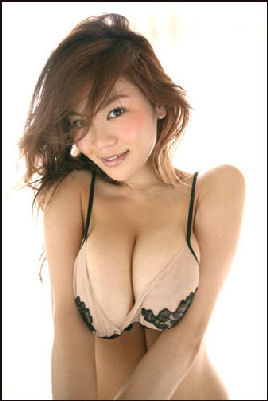
the idol Yokoma Tsugane Japanese women are slim and healthy-looking, and even mothers with several children look surprisingly good. Japanese men reportedly like women with round eyes, long legs and large breasts (late night television shows are obsessed with them) even though not many Japanese women have large breasts. Women that look and act like children and mousy girls with ears that stick out are considered attractive.
A famous Japanese soccer play was asked: What's your favorite feminine mannerism? “I like the way a woman pushes up her hair and reveals her neck and nape,” he said. In the old days, shaved eyebrows and black teeth were considered beautiful and Japanese men thought the nape of the neck and the ankles of a woman were sexy. Part of the reason for this was that they were the only parts of skin exposed by women wearing kimonos.
In 1997, the wacko tabloid, the Weekly World News, reported that 78 percent of Japanese men surveyed would prefer to be on a desert island with Janet Reno than any other woman. The report of course wasn't true. Most Japanese men don't even known who Janet Reno is.
As attractive as Japanese women are there has long been a feeling that Western women were more beautiful. A character in a story published in 1908 by the famous Japanese novelist Soseki Natsume said that the women depicted in ukiyo-e woodcut prints “have disappointing narrow eyes compared with the clear-eyed women depicted in Western paintings...There are no Japanese woman in earth comparable to Madonna of Raffello Sanzio! Should there in fact be such a beauty she would never be considered Japanese.”
These days in Japan, shampoo ads for Proctor & Gambles and Unilever feature glamorous Western blonds while those for the Japanese shampoo Tsubaki feature famous Japanese women and the slogan “Japanese women are beautiful.” Marketing analyst Yoko Kawashima of Itochu Fashion told AP: “Japanese women are starting to have confidence in themselves.” Shiseido, the cosmetics company that makes Tsubaki, she said “didn’t even talk about the shampoo’s features. Its message, that Japanese women on the go are beautiful, was more about feeling.” She also said “Western are saying Japan is cool, and that view is winning acceptance in a kind of reverse import.” Tsubaki became Japan’s No 1 shampoo with sales of 43 million bottles during its first year.
Under traditional Japanese beliefs about beauty revealing too much is indelicate and limits the imagination. The distance from the nape to the collar is measured in fists, with three fists for a geisha and one for a daughter.
Good Websites and Sources: Beauty Trends in Japan marieclaire.com ; Japan Beauty Queen Factory time.com ; Japanese Women Get Thinner japanprobe.com ; Japanese Women Don’t Get Wrinkles www.more.com ; Cool Japanese Hairstyles japanesestreets.com ; History of Hair in Japan opendemocracy.net/arts-hair ; Cosmetics Found in Japan joseibi.com ; Danny Choo on Cosmetic Surgery in Japan dannychoo.com
Links in this Website: BEAUTY, HAIR STYLES AND COSMETICS IN JAPAN Factsanddetails.com/Japan ;MALE BEAUTY, TATTOOS AND COSMETICS FOR MEN IN JAPAN Factsanddetails.com/Japan ; BATHING IN JAPAN Factsanddetails.com/Japan ; HYGIENE AND CLEAN FREAKS IN JAPAN Factsanddetails.com/Japan
Miss Universe from Japan

Riyo Mori In June 2007, Riyo Mori, a 20-year-old dancer from Shizuoka, was crowned Miss Universe in Mexico City. She was the first Japanese to be so honored in 48 years. Akiko Kojima was crowned Miss Universe in 1959. Miss Brazil and Miss Venezuela placed second and Third respectively behind Mori. A Japanese woman — Kurara Chibana — was the first runner up in the Miss Universe contest in 2006.
Hiroto Murasawa, an expert on beauty and cosmetics at Osaka Shoin Women’s University, told the Daily Yomiuri, “Watching her on TV during the finals, I thought she projected a very non-Japanese air. She comes across as a mature, independent woman very adept at expressing herself...I don’t think she was chosen for her Japanese qualities but for other things...Those who make their name overseas are different from those who are popular among Japanese.”
A number of Miss Japan’s have made it into the top five in the Miss Universe contest. The first beauty contest was held in Japan in 1908 under the sponsorship of a newspaper, Jiji Shimo, that chose it entrants based on photos that were sent to it. The contest was opened to all women except geishas and actresses.
White Versus Tanned Skin in Japan
Especially among the older generation, dark skin is considered ugly and lower class, and pale white skin is considered beautiful and an expression of sensitivity and cultivation. There is an expression in Japan that white skin can "hide the seven shortcomings of a woman."
Many women walk around with "sun umbrellas" in the summer so they don't get tan. Umbrellas treated with chemicals sell for up to $350, and special attachments can be purchased so women can an attach their umbrellas to their bicycles. Hats, gloves and arm coverings that protect women from the sun are widely available in Japan.
White face powder and paint is used by geishas and male Kabuki actors. Cosmetic stores sell a variety of cleansers, moisturizers and foundations aimed at generating bihaku ("beautiful white") skin. Some clinics offer special skin-peeling procedures that whiten the skin through laser treatments and application of ultra-cold liquid nitrogen or acid.
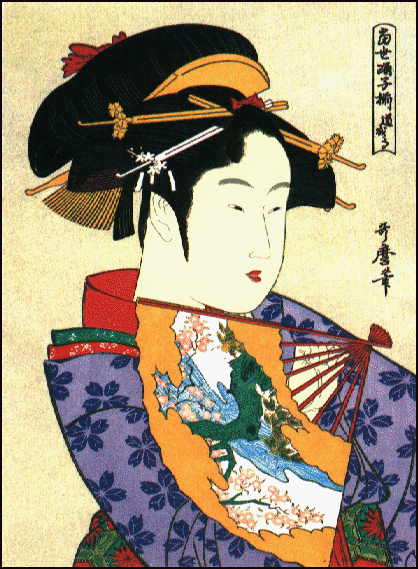
In the mid 1990s, young Japanese with natural, bottled and booth tans were common sights. Ganguros ("black faces") was a name given to girls who with orangish, tanned faces, white lipstick, and heavy make-up, platform shoes and outrageous and colorful clothes. See Women.
Asian Hair
Individual strands of Chinese women’s hair are circular and wider and more resistant to breaking than the oval hairs of Western women. Chinese hair has higher pigment concentrations that makes it glossier and shinier than the hair of Western women and less likely to turn white. Chinese hair is less dense than Western hair with fewer hairs per square centimeter of scalp.
When stripped of its natural pigment, Asian hair has reddish undertones while European hair has yellow-orange undertones. As a result hair dyes for Asian women are made with green that cancels out red while those for European women are made with violet that cancels out the yellow-orange undertones.
History and Hairstyles in Japan
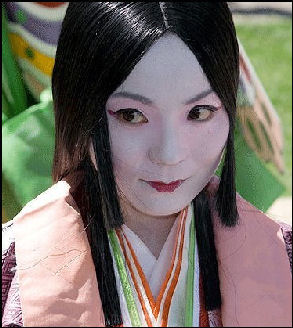
8th century make up and hairstyle Japanese women generally wore their hair long straight until the late 16th century. The practice of tying the hair up geisha-style with combs, kanzashir ornaments, and knitting-needle-like hairpins was not a common practice until the Edo Period (1603-1867) when women began imitating the hairstyles of men, and the kind of hairstyle a woman wore often indicated her class and marriage status.
It is said in Japan that hair is a woman's most vital thing in life (“ “Kami wa onna no inochi””) but as the passage reminds us, in life, despite the best-laid plans, sometimes things can get a bit...hairy.
The “Osafune” hairstyle, with the hair sticking out and pointing down like insect antennas was worn by fashionable wives or mistresses. The butterfly-like “Yoko-hyogo” was worn by courtesans. Girls wore their hair like geishas in a hairstyle called “Momoware”. Unmarried women wore shimadamage hairstyle. The “Taka-Shimada” style, worn by brides today, was originally worn by the high-ranking servants of samurai.
All thee hairstyles were based on the same basic design. First the hair was divided into six parts: the front, the two sides, back, center and chignon (the poofed up part at the crest of the head). The central part is tied with a string and acts as kind of root where the ends of the five other parts are brought together. It said that women were sometimes bald at the central spot as a result of the weight from the hair.
Women often inserted enormous pads in their hair to shape the sides and back into specific designs. Some of the more elaborate ones resembled bird's wings. Hairdressers used dozens of different combs to create a variety of shapes and forms that were held in place with special waxes. The process often took two hours or more. Women often slept on blocks of wood instead of pillows to protect their hairdos.
Japanese Hairstyles Today
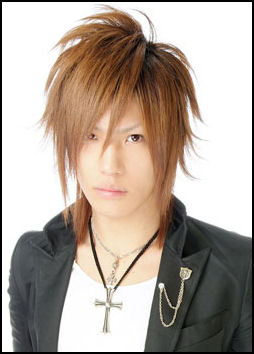
There are lots of hair stylists in Japan. Often there are two or three on a single block. Haircuts in Japan cost around $50 and a typical trip to the beauty parlor costs a $100 or more. Many women get permanents and copy the hairstyle of popular pop singers.
In the 1990s many young Japanese were into dreadlocks and cornrows. In most cities you could find hair stylists that specialized in making them. Explaining why she had corn rows made from her mid-back length hair, one Japanese teenager told the New York Times, “Japanese copy black fashion out of adoration. I was into hip-hop dancing in high school. And I watch videos with rappers and R&B singers. They are proud of their culture, and they’ve got firm opinions. Many Japanese can’t say what they think. I want soft dread next, because my friend wore them and they looked cute.”
The price of wigs, toupees and hair extensions have risen dramatically in recent years as hair extensions have become so popular the demand for them has driven up prices of all products made with human hair. Many Japanese women that use hair extensions use them for a short time and then discard theme. Much of the hair comes from China.
Japanese Hair Style Customs
According to an old custom in Japan, a person is supposed to cut one’s hair following a romantic breakup. In May 2009 online survey by Excite Japan on the custom 24 percent of female respondents and 11 percent of male respondents said they had cut their hair after a relationship ended. The android diva Hatsune Miku, created by Crypton Future Media in 2007, sings a song titled "”Watashi ga kami o kitta riyua4" (“The reason I cut my hair”). In it, the 16-year-old virtual idol declares, "The reason I cut my hair is not to forget you, but to say goodbye to the weak me who can't forget you." "” [Source: Kate Elwood, Daily Yomiuri, May 24, 2010]
The shaved-head style still common among Japanese boys is referred to as bozu, after the Buddhist priests the boys resemble with their shorn hair. It is common among high school baseball players. Sometimes Little League baseball players have their head shaved by their coaches after they make an error or mistake.
In recent years barbers that charge only ¥1,000 ($10) per haircut have become very popular. They charge a cheap price by not shampooing their customers and getting them in and out of the chair quick, often in around 10 minutes, Cost-conscious, in-a-hurry customers find them to be a welcome alternative to expensive hair stylists. Some of the cheap barbers are being threatened by laws that require them to give shampoos for hygienic reasons.
Tokyo-based barber Takashi Yamaguchi was a gold medalist in the "senior gents technical category, creative hairstyle" at the 2006 World Hairdressing Championships in Moscow. Originally based in Kobe, he almost gave his trade after an earthquake-caused fire badly warped his favorite scissors. Among the pieces of advice he tells his students is that “a slight variation in a single cut — even in a few tenths of a millimeter — can improve the impression of the whole hairstyle."
Dyed Hair in Japan
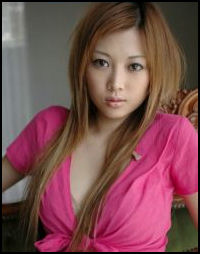
The natural color of Japanese hair has been described as karasu no nureba iro’shining black like a crow’s wings.”
Around 60 percent of the women in Japan dye their hair. Some dye their hair black to cover gray but most dye their hair burgundy, auburn, chestnut, blond and various shades of brown at least partly so they have something other than the jet black hair like all Asian females are born with.
Many Japanese young men and women began dying their hair reddish blond in the mid 1960s to achieve an effect that Japanese surfers get from a summer of hanging out in the sun. You see a lot more dreadlocks, punk haircuts and green and orange dyed hair in Japan than you do in Korea or China.
In 2000, more 30 million kilograms of hair dye was sold in Japan. That works out more than half a kilogram for every Japanese woman over the age of 15.
The issue of whether students and employees should be allowed to color their hair has become an issue at many schools and companies. On a visit to Japan in the early 2000s, Malaysian Prime Minister Mahathir bin Mohammed sharply criticized young Japanese for looking different. "Japanese youths want to be blonds, work less and play more. The traditional Japanese and Eastern culture is being discarded and replaced with Western culture with disregard for filial piety and discipline."
At one middle school in Kitakyushu filmed by the Japanese television station “News Zero” a principal greeted students at the gate and directed those with tinted hair to a designated area where a teacher spray painted their hair black. Video showed students covering their face and eyes while they were being spray painted.
In November 2005, a 27-year-old cabaret club hostess won ¥240,000 in damages from a Tokyo hairdresser on the claim that the hairdresser didn’t do what the hostess wanted to the detriment of her work.
World Record Mohawk on Japanese Man
In September 2012, Julian Ryall of The Telegraph wrote: “The tip of Kazuhiro Watanabe's spiked mohawk stands 3 ft 8.6 inches proud of his skull and earned him a place in the 2013 edition of the Guinness Book of World Records. Watanabe unveiled his hair-do at a press event in New York to mark the launch of the new book. "It was a lot of work ... but I am happy to have achieved the world's No 1," 40-year-old Watanabe told reporters, adding that it had taken him 15 years to grow the mohawk to its present size. [Source: Julian Ryall, The Telegraph, September 13, 2012]
To get it into shape takes three stylists, three cannisters of hair spray and a bottle of hair gel, Watanabe said. Without gel and hairspray, the hair reaches his knees. "It is too expensive to do the mohawk every day, so I only do it for occasions like this and parties," he said. The previous holder of the record for the biggest mohawk was Stefan Srocka, of Germany, with a hair-do that stood 31.5 inches tall.
Watanabe said he began his quest to get into the Guinness Book of World Records when he was 20, although he did not initially mind which record he held. One attempt that he considered before taking on the mohawk challenge was to drink the most tabasco sauce. Watanabe said his 10-year-old daughter has already decided that she intends to beat his record one day.
Edo Period Japanese Make-Up
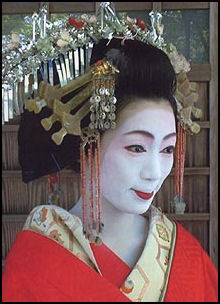
modern courtesan with
white face make up and
elaborate hairstyle In the Edo Period (1603-1867) there basically only three colors for make-up: white for face powders, black for eyebrows and teeth and beni for lips. In the Edo period when women married they shave off their eyebrows.
In the 19th century women painted their teeth black, a custom that was considered to make them attractive. Women painted their teeth with a layer of logwood, a dye made with rice vinegar and pieces of iron and was the same material used to make the base for Japanese lacquerware. Women shaved their eyebrows and blackened teeth, some believe, to hide their natural expression.
In the old days, the red lips of geishas was not made with lipstick but rather with rouge that was kept in a bowl and applied with a brush. Edo period woodblock prints show women applying it. Many Japanese women used “beni”, a material made from flowers that looks green when dry but almost magically turns bright red when water is applied to it.
Sometimes the beni was applied in such thick coatings it looked noticeably green. Beni is still sold by the Japanese cosmetics company Isehand, It is worn mostly by women who wear kimonos and is said to have a lighter and more natural feel than lipstick and is better at bringing out the natural color of one’s lips. A jar a high quality beni, enough for 40 or 50 applications, sell for around $100. One of the main reason it is so expensive is that it requires enormous amounts fo safflower to make.
Cosmetics and Perfumes in Japan

Cosmetics package from the 1920s The cosmetic market in Japan was worth $12.4 billion in 2005,
Cosmetics are very expensive on Japan, in many cases double what they are in Europe and the United States. Many Japanese women who have friends traveling abroad ask those friends to bring them back some lipsticks, cosmetics, cleaners or perfume.
Spending per person on herbal products (2000): $5.80 (compared to $15.20 in the United States). [Source: Euromonitor]
The perfume market is fairly big in Japan considering many people don’t even era it. Perfume is often given as a gift and then put on the shelf and never used. Japanese that use perfume like delicate fragrances. By contrast the French like flower scents and Germans like pine scents.
Since ancient times Japanese clocks burned different incense every fifteen minutes. In the Edo Period geishas were paid by the number of scent sticks that were consumed.
The Japanese are great believers in massage when it comes to beauty and health. Mothers massage the stomachs of constipated infants. Fathers massage the feet of children they want to be athletes and elderly women massage their faces to keep their skin looking good.
High-End Cosmetics in Japan
Many Japanese cosmetics companies have developing products for the ultra high-end market, with some facial creams costing more than $1,000. A 45-gram packet of Kose’s Cosme Decorte AQ Cream Meliority sells for $800. Shiseido’s Cle d Peau Beaute Synergique skin cream sells for $1,260 on its own and $2,000 in a set with lotion and other items. Many women have hoped price would come down after Japanese cosmetics makers were accused of rigging prices. That hasn't happened.
There are big profits and growth potential in the high-end market. Many of the women who buy them are in their 40s, 50s and 60 and are worried about wrinkles and blemishes. Their kids have grown and they have lots of money. Japanese cosmetics makers are actively courting women around the age of 40 (“ara-fo”) who have a reputation for being attracted to luxury products. These women generally started working in the late 1980s and early 1990s in the last throes of the bubble economy when they developed their taste for the finer things in life.
Many of the products have unusual ingredient, advance production techniques and fancy containers. Soin Absolute Cream de Nuit B21, made by Orlanne Japon, sells for $310 per 50 milliliters and contains special rice and soy bean extract. In a boutique called Accessory Creation Mix, female customers can get cosmetics customer made for their individual skin complexion.
Speciale cream, made by Noevir, sells for $1,000 for 50 grams. It is made with nanotechnology that creates superminute, emulsifier particles that permeate the skin surface better than large particles. Similar technology is used to make especially lethal anthrax bioweapons.
Kanebo’s Twany Century Cell Rhythm SPO cream, retails for $1,250 for 40 grams. It is said to retard the aging process by seeping into skin smoothly. A spokesman for Kanebo told the Kyodo News, “Buyers are mostly in their 50s and 60, and some of the women say they reward themselves for their year’s work by buying our cream.”
Kanabo sells a super luxurious medicinal cream for ¥126,000 and a face lotion for ¥21,100.
Japanese Cosmetics Companies
Shiseido is the largest cosmetic manufacturer in Japan and the forth largest in the world. Other major Japanese cosmetics companies include 2) Kanebo, 3) Kose and 4) Kao. They and other Japanese and foreign cosmetics companies fight over a market for women and men that is worth more than $12 billion a year.
Shiseido’s net profit rose 73.8 percent in fiscal 2009-2010 to ¥33.67 billion thanks mostly to cost-cutting efforts. Shiseido is pinning future profits on 10-percent-a-year sales growth in China. As part of their plan to become a global brand, Shiseido bought San-Francisco-based Bare Escentuals — known for its bareMineraks and Buxon cosmetics brands “ for $1.7 billion. The company is even selling products in South Africa
In November 2009, Shiseido said a recall of 1.14 million eyelash curlers over possible defects — metal fatigue that caused two parts to break — that caused minor injuries to two women.
In the mid 2000s, former president of Kanebo and two former executives were arrested for window-dressing company books. The president and vice president of the company were found guilty but were given suspended sentences for falsity company financial statements,
Kanebo is moving aggressively into China. It sold its products in 500 specialty stores at the beginning of 2011 and hopes to be selling them in 1,000 stores by the end of the year. Kanebo is also marketing products in the Czech Republic and Hungary. In December 2005, Kao, Japan’s largest maker of household goods, said it would buy Kanebo Cosmetics for $2.4 billion.
Japanese-made beauty products sell well in Asia. The Kao Corp.’s Liese Bubble Hair Color line, for example, is popular in Singapore and other places because it can be shampooed in without worrying about it dripping down your face. Japanese cosmetics companies are increasingly looking to the Asian middle class to expand their businesses.
Shu Uemura
Shu Uemura is one of Japan’s biggest cosmetics companies, Currently owned by L’Oreal, it was founded by Japanese make-up artist named Shue Uemura, who made a name for himself in the 1950 transforming Shirley MacLaine into a Japanese geisha in the film “My Geisha”. He had been asked to fill in for MacLaine’s make up artist who had fallen ill and was praised fr making MacLaine look like an Asian. He also worked with Frank Sinatra , Marilyn Monroe and others before founding his cosmetics company in 1967.
Shu Umera is regarded as a major innovator in the make up business. He introduced brushes and cases and make up used by professional make-up artists to general consumers. In 1983, he opened a cosmetics boutique in Omotesando in Tokyo with an “open atelier” display style that allowed shoppers to try the make up without the help of a sale person. Now the method is standard f the industry.
Shu Umera’s product range included 96 colors of lipstick and 108 different colors of eye shadow. His designs changed with the season and the audience they were intended for. His checkerboard eye lid design called “Flaggy” was one of his most famous and extreme designs. His eyelash curler was mentioned by name in the film “The Devil Wears Prada”. Karl Langerfield was a big fan and like the texture his eye shadows. Today Shu Umera brand s sold in 18 countries Uemura; died in December 2007 at the age of 79.
Fingernails, Eyelashes and Teeth in Japan
Fingernail art is popular in Japan. On television there are competitions with women who have attached beads, feathers, sea shells and other materials to their nails and made them look like Teddy bears and garish works of art. Some vending machines offer manicures for $12.50. Drop in the money, select the colors and it paints two fingers at a time with an automated brush.
Many young women and some young men shave their eyebrows, pluck them in strange ways, or get eyelash perms.
Many Japanese have bad or crooked teeth. This is partly attributed to the relatively recent introduction of sugar to their diets. Only recently have they began addressing the problem. The number of dentist almost doubled between 1978 and 1998 to 88,000. The sale of tooth whiteners, dental floss and dental surgery are increasing. Women's rest room in work places are filled with toothbrushes religiously used by women to clean their teeth after lunch.
Japanese of both sex are paying a fortune to have their teeth whitened with lasers, straightened with $10,000 braces and capped. Because major dental work is so expensive in Japan and not covered by health insurance, many Japanese go to Thailand to get their teeth straightened or have caps put on them.
3-D Nail Design
Takamasa Sakurai wrote in the Daily Yomiuri, On a street crowded with female anime fans, called "Otome Road" in Tokyo's Ikebukuro area, there's a small nail salon called Melody Nail, which is known for its unique 3-D nail art designs. The salon, run by Ai Nakamura and Akiko Iwata, enjoys a booming business serving young fashionistas."Nails are often said to be the last body part that we make look stylish. We take care of our makeup and hair, but nails tend to come later," Nakamura, 25, said. "I hear my customers saying they're happy to be complimented on their nails." [Source: Takamasa Sakurai, Daily Yomiuri, June 22, 2012]
“Nakamura said she's been into nail fashion since high school. She is happy to see her customers get excited having her doing their nails. "People look at your nails, and you, too, always see them without needing a mirror. Taking care of nails and keeping them stylish will make you feel good and also gives a good impression," she said.Iwata, a former aesthetician, was so enchanted by the beauty of nail art that she changed her career to become a nail artist. Iwata used to enjoy drawing when she was a child.
“3-D nail art hasn't become popular overseas yet. Lady Gaga's nails are well known, but the artist [who does them] is Japanese," she said. "I think Japanese people are good at doing fine, detail work such as 3-D designs on nails.”
“Nakamura calls herself an anime otaku. Recently, an increasing number of fashionable girls tend to be anime otaku as well. For young women like Nakamura, there's no boundary between fashion and otaku. "I think those who are into something are called otaku. In that sense, I'm an anime and fashion otaku," Nakamura said. One of the reasons why they opened the salon in Ikebukuro is that the district is a mecca for anime fans. The area has many anime and manga shops near a major station, with fashion and brand shops nearby. Ikebukuro satisfies consumers who are hungry for fashion and manga or anime goods, something that can't be achieved in Harajuku or Akihabara.

double eyelids
Cosmetic Surgery in Japan
Common cosmetic surgery procedures performed in Japan include breast enlargements, bellybutton alterations, facial reconstruction surgery that alters the cheekbones and chin, and operations to create a pointy nose, turn up nose, shrunken nostrils and full lips.
Many teenage girls and young women want long legs, big breasts and Caucasian features and hair. During the mid-1990s, when halter tops and bare mid-rift fashions were all the rage, many Japanese women and young girls spent $1,000 for 20 minute operation that transformed their "unsightly" round belly buttons into sexier vertical slits.
One of the most common surgical procedures in Japan is the double-slit operation. Many Japanese women don't have a crease over the top of their eyelid like Western women do. This crease, along with round eyes, in considered beautiful by some people. The double slit operation adds a crease above eyelids with a scar-making incisions and cost about $1200. Nearly all patients who have had the operation done consider it worthwhile.
Many university students have double-slit the operation done during their winter vacation. After the surgery is completed they are not allowed to wash or wear make-up for a week. Afterwards it takes about a month their swollen face returns to normal.
Breast enlargements are also common. A favorite topic of discussion on gossip shows are the Kano sisters. They have made an entire from showing of their surgically-enhanced breasts.
Eyelash extension procedures became popular in the mid 2000s. Made of silk or nylon, the extensions are applied one lash at a time to person’s natural lashes with a special adhesive, The extensions vary in length and degree of curl and customers can decide how many the want applied. The procedure is carried out at beauty parlors and last for three or four weeks, Young women like them because they say their eyelashes look more natural than with false eyelashes.
There are no legal restrictions on eyelash extensions and anyone can put them on. There have been a number of complaints of eyelid pain, bloodshot eyes and general eye irritation and puffiness, One woman who had the procedure done and was unable to open her eyes. Most of the problems are associated with the adhesive — an instant glue — which is dangerous if it come in contact with the eye.
Problems with Cosmetic Surgery in Japan
One of the Kano sisters made headlines when she sued her plastic surgeons for botching her surgery. She claimed she told the doctor she wanted her nipples made smaller and claimed he lopped one of them off. "My nipples are my life," she famously declared. People who had a look at her nipples said they looked just fine.
More than 10 percent of cosmetic surgery patients complain of botched surgery. One woman who got a simple double slit operation told the Yomiuri Shimbun that afterwards her face was so swollen she had to miss 10 days of work. Another woman who had breast enlargement surgery said that after the operation her breasts were crooked and different sizes. A third said that after a nose job her nose moved every time she blew it.
Many of the problems are blamed on cosmetic surgery clinics that advertise in magazines and community newsletters with claims like "removing surplus fat is a safe treatment" and "changing yourself only takes about 15 minutes." .
In January 2005, a 21-year-old woman committed suicide and left behind a suicide note that she did it because of “the unsuccessful surgery on my eyes” which has “been tormenting me since I had the operation when I was 18.” The woman had large eyes and had surgery to shrink then down so they looked like those of the pop singer Ayumi Hamasaki. The operation didn’t go well and left her with swollen eyes and eyelids that she was unable to close. The fat under her eyelids had been completely removed, so her muscles obstructed one another, preventing them from properly closing. She underwent a series of operation to try and return her eyes to their original state.
Anorexia and Diet Pills in Japan
Anorexia was first documented in Japan in the 1960s. Between 1980 and 1998 the number of women with eating disorders in Japan increased tenfold. Now it affects an estimated one in a hundred Japanese women, compared to 5 to 10 in a 100 in the United States.
The causes of anorexia are the same as those in the West: the image of thin women conveyed in fashion magazines and the media. In many cases the women who became obsessed with their weight are already very thin.
One anorexia victims, who weighed only 39 kilograms and lacked the energy to move, told Reuters, "I used to read magazines and I liked the clothes I saw. But the clothes were only available in small sizes. When I tried them on in the shops they didn't fit, so I decided wanted to lose weight."
In a study by Prof. Teruko Ikuna of Kobe College, 78 percent of grade school girls said they worried about their weight, 59 percent said they wanted to lose weight and 58 percent said the were disgusted with themselves when they gained weight.
Image Sources: 1) from Hector Garcia site 2) Japan Zone 3) British Museum 4) and 7) Liza Dalby 5) Tokyo Pictures 6) Ray Kinnane 8) Visualizing Culture, MIT Education, 9) xorsyst blog
Text Sources: New York Times, Washington Post, Los Angeles Times, Daily Yomiuri, Times of London, Japan National Tourist Organization (JNTO), National Geographic, The New Yorker, Time, Newsweek, Reuters, AP, Lonely Planet Guides, Compton’s Encyclopedia and various books and other publications.
Last updated January 2021
